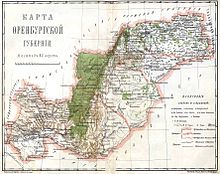Orenburg governorate
The Orenburg Governorate ( Russian Оренбургская губерния / Orenburgskaja gubernija ) was an administrative unit of the Russian Empire in the steppe zone south of the Ural Mountains . It bordered (clockwise from the north) with the following governorates and territories: Perm , Tobolsk , Turgai , Uralsk , Samara and Ufa . According to today's understanding, its territory included not only Orenburg Oblast , but also parts of Kurgan and Chelyabinsk as well as some strips of territory in Kazakhstan . It had an area of 191,179 km², the capital was Orenburg .
The governorate was founded in 1744 and transferred to the Ufa Lieutenancy in 1782, but its administrative seat was relocated to Orenburg again in 1796, which gave the area its later name. In 1865 the Ufa governorate was split off. The Orenburg governorate existed until 1928 as part of the Russian SFSR of the Soviet Union . After the dissolution, its territory was incorporated into the newly formed Middle Volga Oblast .
The governorate was divided into the following districts ( Ujesdy ):
- Orenburg
- Orsk
- Troitsk
- Chelyabinsk
- Verkhneuralsk
statistics
At the 1897 census, the governorate had 1,600,145 inhabitants. Of these, 1,126,040 were Russians, 254,561 Bashkirs (plus 16,877 Teptyars ), 41,541 Minor Russians (Ukrainians), 92,926 Tatars , 38,403 Mordvins and various smaller groups. The Orenburg Cossacks made up almost a quarter of the population .
The economic importance of the governorate resulted from its wealth of mineral resources, especially gold, copper, iron and salt. In 1901 there were 435 gold pansies producing 2,657 kg of wash gold, while 1722 kg of gang gold were also extracted. 13,251 tons of copper ore were extracted, 1,771 tons of chrome iron ore, 133,053 tons of iron ore (in particular magnetite from the Magnetberg, on which today's Magnitogorsk is located) and 25,387 tons of rock salt. In addition, agriculture and animal husbandry are the main occupations. The harvest in 1902 resulted in: 523,882 tons of wheat, 28,142 tons of rye, 141,810 tons of oats, 20,139 tons of barley and 88,872 tons of potatoes. In 1902 the number of cattle was 716,000 horses, 848,000 horned cattle, 1,149,000 sheep, 77,000 goats and 47,000 pigs. Vegetable and fruit growing were not very well developed, but fishing and beekeeping were secondary trades. Industry, with the exception of mining, was completely insignificant at that time. In 1900 there were 189 factories with 5,715 workers and a production value of around 14 million rubles.
The region experienced an important upswing with the Trans-Siberian Railway , the main line of which ran via Chelyabinsk in the 19th century.
Web links
- Census results 1897 (language groups) (Russian)
- Census results 1897 (administrative districts) (russ.)
- Orenburg. In: Meyers Großes Konversations-Lexikon. Volume 15. Leipzig 1908, p. 110.

